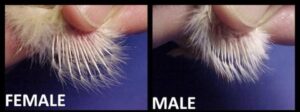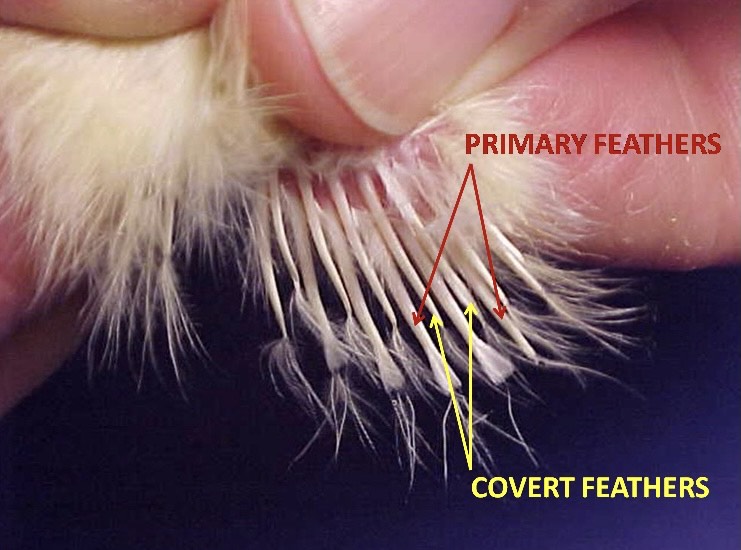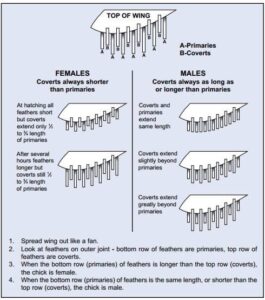Feather Sexing in Poultry
I have come across several posts from Ameraucana breeders asking if their chicks can be feather sexed. Feather sexing using sex-linked genes related to feather development is a widely used chick sexing method in the poultry industry. In order for feather sexing to be accurate, it must be specifically bred for and involves controlled matings and selection.
In poultry, females carry a Z and a W chromosome and males carry two Z chromosomes. It takes a pair of sex-related chromosomes to determine the sex of the offspring. The mother contributes one sex chromosome to the offspring, and the father contributes the other. It is the female, therefore, that genetically determines the sex of offspring in poultry.
The locus of the feather development gene (K) is located on the Z chromosome. A feather sexing line can be created in poultry from using early-feathering (k) and late-feathering (K) genes.
By establishing maternal stock with the dominant gene (K) and paternal stock with the recessive gene (k), the slow-feathering characteristic is passed from mothers to their sons and the rapid-feathering characteristic is passed from fathers to their daughters. The males produced typically have shorter primary feathers than the females. In the females, the covert feathers are shorter than the primary feathers. In the males, the covert feathers are as long as, or longer than, the primary feathers.
 Somes (1970) reported on a third allele (Kn) at the K locus. This allele is dominant to both K and k and results in an extremely delayed feathering.
Somes (1970) reported on a third allele (Kn) at the K locus. This allele is dominant to both K and k and results in an extremely delayed feathering.
A scientific study completed in 1977 identified a fourth allele at the K locus. The new allele was found to be dominant to late feathering (K) and to early feathering (k). The term “slow” was suggested and it was labeled with the symbol KS (McGibbon, 1977).
The probable order of dominance of the alleles at the K locus is KN→KS→K→k.
Several scientific studies have been completed to assess the effects of the K alleles.
A study in 2012 found that the presence of slow feathering was connected with lower fertility and hatchability. Presence of slow feathering also resulted in lower body weight of birds at 36 weeks of age (Sohn et al, 2012). A study completed in 1961 found that the k allele was associated with bigger chicks at hatch (Saeki et al, 1961).
A study completed in 1961 found that the k allele was associated with bigger chicks at hatch (Saeki et al, 1961).
A study completed in 1965 associated early maturity and larger eggs with the k allele (Lowe et al, 1965).
The influence of the sex-linked rate of feathering allele, Kn, was compared to that of birds carrying the k allele in a study completed in 1970. The Kn allele was associated with reduced body weight, egg production, hatchability and liveability compared to birds carrying the k allele. It also increased age to maturity (Somes, 1970).
Hopefully this educational post will be helpful to breeders that are curious about feather sexing, the K locus, and the effects of the various K alleles! 
References
Bang, M. H., Cho, E. J., Cho, C. Y., & Sohn, S. H. (2018, September). Study on the Characteristics of Feather Developing Pattern and Morphology in Early- and Late-Feathering Korean Native Chickens. Korean Journal of Poultry Science. The Korean Society of Poultry Science.
Cerit & K. Avanus (2007) Sex identification in avian species using DNA typing methods, World’s Poultry Science Journal, 63:1, 91-100.
Jacob, J. 2016. Sexing Day-old Chicks on Small and Backyard Flocks. Kwon, J. H., Choi, E. S., & Sohn, S. H. (2021, March). Establishment of Korean Native Chicken Auto-Sexing Lines Using Sex-Linked Feathering Gene. Korean Journal of Poultry Science. The Korean Society of Poultry Science.
Lowe, P. C , S. P. Wilson and R. B. Harrington, 1965. Association of some qualitative and quantitative traits in chickens. Poultry Sci. 44: 106-112 McGibbon, W.H. A Sex-Linked Mutation Affecting Rate of Feathering in Chickens, Poultry Science, Volume 56, Issue 3, 1977, Pages 872-875, ISSN 0032-5791.
Mincheva N, Lalev M, Oblakova M, Hristakieva P, Ivanova I 2012 Effect of feathering alleles (K/k+) on laying performance, hatchability parameters and some body measurements in two lines of white Plymouth Rock hens. Biotechnol Anim Husb 28(3):405-414.
Saeki, Y., and T. Katsuragi, 1961. Effect of early and late feathering gene on growth on New Hampshire, Leghorns and their crossbreds. Poultry Sci. 40: 1612-1616. Sohn, S.-H., Park, D.-B., Song, H.-R., Cho, E.-J., Kang, B.-S., & Suh, O.-S. (2012, August 31). Genotype Frequencies of the Sex-Linked Feathering and Their Phenotypes in Domestic Chicken Breeds for the Establishment of Auto-Sexing Strains. Journal of Animal Science and Technology. Springer Science and Business Media LLC.
Somes, R.G. The Influence of the Rate of Feathering Allele Kn on Various Quantitative Traits in Chickens, Poultry Science, Volume 49, Issue 5, 1970, Pages 1251-1256, ISSN 0032-5791.
